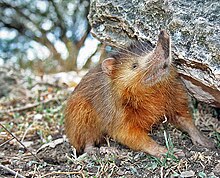According to a study published in Mitochondrial DNA, confirmed that the venomous mammal solenodon diverged from all other living mammals 78 million years ago, long before an asteroid wiped out the dinosaurs.
An offspring's nuclear DNA is a mixture of genes from each parent while mitochondrial DNA is passed directly from mother to offspring without changes, creating a genetic record that researchers can use to trace back the lineage of organisms.

Because solendons are endangered, it is difficult to acquire DNA. Working with colleagues at several universities in the Dominican Republic, UPR Professor of Generics Taras Oleksyk and his team collected samples by laying on the ground and waiting for the solenodons to crawl across their bodies.
A previous study used a different set of genes to estimate that solenodons diverged from mammals during the Cretaceous Period 76 million years ago. Working with an expert at Texas A&M, this study used a very different method but still established a similar estimate: 78 million years.
Interestingly, these two estimates align with a hypothesis regarding how the solenodon came to inhabit the island of Hispaniola. Some geologists speculate that the island was part of a volcanic arc connected to Mexico 75 million years ago and over time the arc has moved eastward.
No comments:
Post a Comment